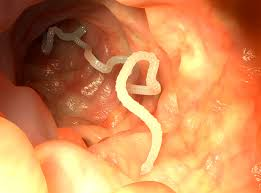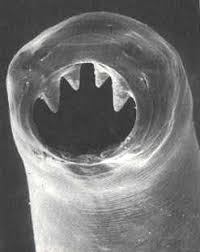9_IHD
Learning Outcomes
Understand the burden of parasitic infestations on human health
Define parasites and identify the three types of disease-causing parasites:
Helminths
Protozoa
Ectoparasites (e.g., fleas, lice, mites, ticks)
Classify helminths and explain common anthelminthic drugs
Describe the general morphology and life cycles of protozoans
Explain the sporozoan life cycle stages in humans and mosquitoes
Parasites
Definition: A parasite is an organism that lives on or in a host and derives nourishment from that host
The bacteria does not have a symbiotic relationship with the host because the host is the only one that get benefits
Types of parasites:
Helminths: Worm-like organisms
Protozoa: Single-celled organisms
Ectoparasites: External parasites (e.g., fleas, lice, mites and ticks).
Helminths
Overview
→ Large, multicellular organisms, generally visible to the naked eye in their adult stages
Can be free-living or parasitic
Adult helminths cannot multiply in humans
Three major groups of human parasites:
Flatworms (Platyhelminths): Includes trematodes (flukes) and cestodes (tapeworms)
Thorny-headed worms (Acanthocephalins): Adult forms reside in the gastrointestinal tract
Roundworms (Nematodes): Adult forms are found in various body systems (GIT, blood, lymphatics, or SC tissues); larval stages can cause diverse diseases
Helminths: Flatworms & Acanthocephalins
Tapeworm (Cestodes)
Example: Taenia species

Flukes (Trematodes)
Example: Fasciola species

Thorny-headed worm
Example: Moniliformis moniliformis
Roundworms
These kinds of helminths are more commonly recognised
Hookworm: Example: Ancylostoma duodenale

Pinworm: Example: Enterobius vermicularis (found in the sigmoid colon)
Roundworm: Example: Ascaris lumbricoides
Whipworm: Example: Trichuris trichiura
Helminth Infestations
Overveiw
Affect 2 billion+ people worldwide
Major issue in veterinary medicine
Significant impact on animal welfare, public health, and food safety
Epidemiology
Polyinfection (Multiple parasite infections at once) is common in tropical regions.
Transmission & Lifecycle
Invade the host via skin or GI tract
Develop into well-developed parasites but they cannot replicate in the host
Helminths vary in: lifecycle, body structure, development, physiology, localisation in the host and drug susceptibility
Anthelminthic Drugs
Drug | Mechanism of Action | Effect |
|---|---|---|
Benzimidazoles | Inhibit tubulin polymerization | Disrupts microtubule formation, impairing glucose uptake → Worm death |
Praziquantel | Increases calcium influx into the parasite | Causes muscular paralysis and tegument damage → Worm expulsion |
Pyrantel | Depolarises the neuromuscular junction of the parasite | Causes paralysis → expulsion in stool |
Ivermectin | Activates glutamate-gated chloride channels | Functions as a depolarizing neuromuscular blocker → Flaccid paralysis |
Protozoa
Overview
Definition: Microscopic, unicellular organisms either free-living or parasitic.
Protozoa can multiply in humans, enabling significant infection potential from a single organism.
Transmission routes:
Faecal-Oral Route: Contaminated food/water or person-to-person contact.
Mainly for protozoa that live in the human’s intestine
Arthropod Vectors: Mosquitoes or sand flies transmit blood or tissue-dwelling protozoa.
Mainly for protozoa that live in the blood/tissues
Classification of Protozoa
Based on locomotion (their mode of movement):
Phylum | locomotion type | Group | Examples |
Sarcodina | Pseudopodia (false feet) | Amoebae | Entamoeba Histolytica |
Ciliophora | Cilia | Ciliates | Balantidium |
Mastigophora | Flagella | Flagellates | Garidia, Leishmania |
Sporozoa | Non-motile | N/A | Plasmodium, Cryptosporidium |
Common Protozoa
Leishmania
Entamoeba histolytica
Plasmodium falciparum
Balantidium
General Features
Definition:
Protozoa are unicellular, eukaryotic microorganisms that can be free-living or parasitic, capable of surviving in water, soil, or within a host.
Locomotion:
Cilia
Flagella
Pseudopodia
None
Reproduction:
Both sexual and asexual.
Encystment:
Fromation of cysts (dormant, resistant form)
Helps protozoa survive in harsh environments
Like hibernation, encystment allows these organisms to conserve energy and resources until conditions become more favorable for growth and reproduction.
Plays a role in transmission to new hosts
Nutrition Types:
Protozoa are heterotrophic
Holozoic - ingest solid food by phagocytosis
Saprozoic - Absorb dissolved nutrients
Protozoal Asexual Reproduction
Protozoa primarily reproduce through asexual methods, which allow rapid population growth.
Types of asexual reproduction:
Binary Fission (Longitudinal): Producing two equal daughter cells.
Budding: Producing unequal daughter cells (smaller bud detaches).
Schizogony: Multiple fission, leading to numerous daughter cells.
Plasmodia [Haemosporidia]
→ Protozoa causing malaria
Overview
Humans are affected by 5 plasmodium species
All species attack RBC’s
All species cause Malaria
One of the most significant parasitic diseases globally 🌍
Species / Types of Malaria
Species | Type of Malaria | Fever Pattern | Severity |
|---|---|---|---|
Plasmodium vivax | Benign Tertian | Every 48 hours (Day 1 & Day 3) | Mild, non-fatal |
Plasmodium ovale | Ovale Benign Tertian | Every 48 hours (Day 1 & Day 3) | Mild, non-fatal |
Plasmodium malariae | Benign Quartan | Every 72 hours (Day 1 & Day 4) | Mild, non-fatal |
Plasmodium falciparum | Malignant Tertian | Every 48 hours (Day 1 & Day 3) | Severe, can be fatal |
Parasite and Vector
Malaria is a caused by the invasion of parasites, and a crucial step in the disease is the vector (transmission agent)
Vector: Infected Anopheles (mosquitos).
When feeding on humans
Infection: Red blood cells may contain P. falciparum malaria parasites.
Global Burden of Malaria
Epidemiology (WHO Report 2023)
263 million cases of malaria globally
597,000 deaths reported
94% of deaths occur in sub-Saharan Africa
Children under 5 years account for 80% of malaria deaths
Geographical Distribution
Eradicated in temperate regions,
Endemic in parts of Africa, Asia, and South America.
COVID-19 Impact
From 2000 to 2019, malaria mortality rates fell by 60% globally
However, progress stagnated during the COVID-19 pandemic due to:
Disruption of healthcare services
Delayed mosquito control programs
Reduced access to antimalarial treatments
Plasmodia - Exoerythrocytic Cycle
*Occurs in liver
Infected female Anopheles (mosquito) bites a human and injects sporozoites from their salivary glands
Sporozoites enter the blood stream
Sporozoites travel to the liver and penetrate/infect liver cells (takes ~30 min).
Asexual multiplication (schizogony) occurs in the liver; lasts 5-16 days.
Schizonts rupture (end of primary cycle)
releasing merozoites, which can reinfect liver (secondary cycle).
Plasmodia - Erythrocytic Cycle
*Occurs in the bloodstream
Merozoites invade erythrocytes (RBC’s).
Asexual reproduction (erythrocytic schizogony) continues:
Released merozoites reinfect other RBC’s.
Incubation period (before clinical signs of malaria) involves ~ 2 exoerythrocytic and 1/2 erythrocytic cycles.
RBC’s burst after a specific period:
48 (P. vivax, P. ovale) or 72 hours (P. malariae).
Malarial fever results from toxins released by the rupture of RBC’s.
Plasmodia - Sexual Cycle
Some merozoites produce sexual gametocytes which do not develop further in red blood cells.
Uninfected Anopheles mosquitoes take infected blood, allowing gametocyte maturation into sperm and egg in the mosquito gut.
*Gamates mature in the female gut
Plasmodia - Sporogonic Cycle
Male (microgamete) and female (macrogamete) gametes fuse after fertilization.
Forms a motile zygote (oökinete). Oökinete penetrates the stomach wall of the mosquito.
Forms an oöcyst, which undergoes meiotic and mitotic divisions (sporogony)
Oocyst ruptures and releases sporozoites that migrate to salivary glands.
Plasmodium falciparum Morphology
Plasmodium falciparum is the most dangerous species of Plasmodium and causes malignant tertian malaria. Its morphology varies at different stages in its life cycle, from sporozoites to gametocytes.
1. Sporozoite (Infective Stage)
Location: Found in the mosquito salivary glands and injected into the human bloodstream during a mosquito bite.
Function: Infects liver cells (hepatocytes) to begin the exoerythrocytic cycle.
2. Merozoite (Liver to Bloodstream Stage)
Location: Released from the liver into the bloodstream.
Function: Infects red blood cells (RBCs) and starts the erythrocytic cycle.
3. Trophozoite (Early Blood Stage)
Location: Inside infected RBCs, feeding and growing.
Function: Trophozoites actively feed on hemoglobin. They are also responsible for the cyclic fever pattern in malaria.
4. Schizont (Mature Blood Stage)
Location: Inside RBCs, containing many merozoites ready to be released.
Function: Divides by schizogony to produce multiple merozoites.
5. Gametocytes (Sexual Stage)
Location: Found in the blood, but not inside RBCs. Male gametocytes are smaller and round; Female gametocytes are larger and crescent-shaped.
Function: Ready to be ingested by an Anopheles mosquito during a blood meal to continue the life cycle in the mosquito.
Quick Identification Tip
Trophozoite (ring form) in RBCs = Plasmodium falciparum
Gametocyte = Crescent shape
Multiple merozoites inside RBCs = Schizont
Oöcyst on the exterior stomach wall of the mosquito.
Epidemiology & Pathology - P. vivax
Most widespread, species of Plasmodium
Accounts for 43% of global malarial cases.
Once common in parts of Northern Europe before it was eradicated
Causes Benign Tertian Malaria
Characterised by recurring fever every 48 hours
Symptoms: mild but debilitating
Untreated infections can persist for up to 5 years due to liver reservoirs, causing relapses.
Epidemiology & Pathology - P. malariae & P. ovale
P. malariae:
Localisation: Tropics and sub-tropics
7% of malarial cases, causes quartan malaria.
Causes a quartan Malaria (recurring fever every 72 hours)
Symptoms mild in adults but can cause nephrotic syndrome in children, persisting up to 40 years if untreated.
P. ovale:
Least common Parasite: less than 1% of cases
Localisation: West Africa mostly
Causes ovale tertian malaria; benign relapses may occur
Specific natural vector has not been identified
Epidemiology & Pathology - P. falciparum
Causes 50% of global cases.
Most lethal
Localisation: Widespread in the Tropics and Sub-Tropics
Causes malignant tertian malaria
Infected RBC’s grow to have prejected knobs which can cause obstructions in the blood vessels
Thrombosis and/or local ischaemia
Cerebral Malaria
Blackwater fever
Lacks a secondary exoerythrocytic stage; no relapses.
Attacks last ~ 36 Hrs and may overlap
Controls of Malaria
Past Approaches
Eliminating mosquito breeding grounds through:
Water drainage, covering wells, spraying insecticides, personal protection.
Treatment of infected individuals to remove reservoir
WHO eradication efforts from 1955-1970 using DDT and other insecticides ended in failure, transitioning to control strategies.
Present
Modern measures include:
Long-lasting insecticide-treated nets.
Indoor residual spraying.
Presumptive treatments in infants, young children, and pregnant women.
Access to effective treatments for febrile children and capacity for early epidemic response.
Education and communication
The ability to detect, prepare, and respond to early warnings of epidemics
Vector Control
Vector control is vital for reducing transmission, with:
Indoor residual spraying (IRS) and long-lasting insecticidal nets (LLINs).
Increasing resistance to insecticides poses challenges to control strategies.